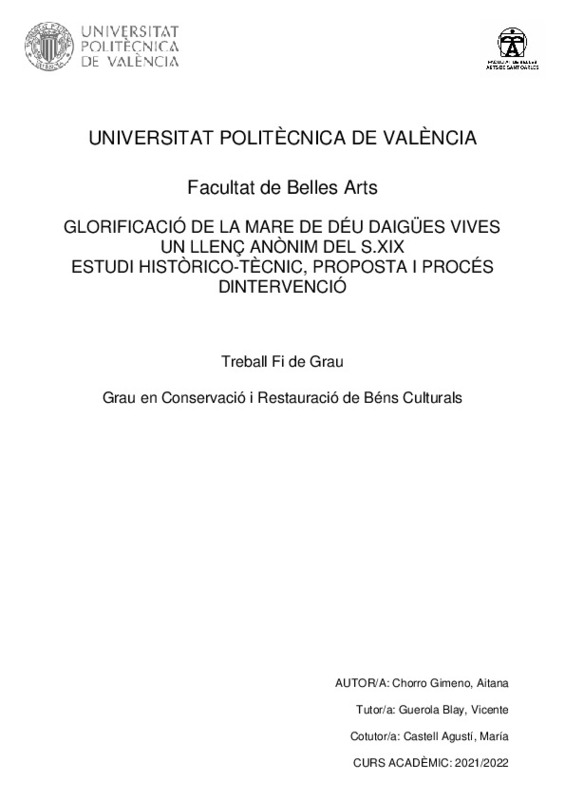|
Resumen:
|
[ES] Al present Treball de Fi de Grau es desenvolupa l¿estudi històric, iconogràfic, tècnic, a més de la proposta i procés d¿intervenció en una pintura sobre llenç amb la representació de la Mare de Déu d¿Aigües Vives. La ...[+]
[ES] Al present Treball de Fi de Grau es desenvolupa l¿estudi històric, iconogràfic, tècnic, a més de la proposta i procés d¿intervenció en una pintura sobre llenç amb la representació de la Mare de Déu d¿Aigües Vives. La tradició remunta la troballa d¿aquesta imatge l¿any 1250, que actualment es conserva a la Parroquia de l¿Assumpció de Carcaixent, procedent de la Desamortització del Convent amb la mateixa titularitat que hi ha al terme municipal. El llenç es pot situar cronològicament a mitjan segle XIX, arran d¿haver localitzat la seua font gràfica directa en un gravat de Tomàs Rocafort i López (fl. 1798 ¿ 1835), en el qual a més de la representació mariana apareix en la part inferior el perfil urbà de la localitat.
El llenç presenta un format rectangular, si bé no són les mesures originals donat que en algun moment l¿obra va ser mutilada en tot el seu perímetre. Aquest és el principal dany que ha patit la pintura, a més de puntuals descohesions i pulverulència produida als marges degut als plecs que es van produir al moment de la nova emmarcació. Cal remarcar la brutícia superficial que presenta la pel·lícula pictòrica, a més d¿una oxidació del vernís que impedix una correcta visualització dels cromatismes originals.
La nostra aportació consisteix, bàsicament, en estudiar i proposar una intervenció de recuperació dels marges perduts i un nou sistema de muntatge i exposició, conjuntament amb una revisió de la neteja de la pintura a partir de protocols actualitzats d¿eliminació de brutícia i vernissos oxidats.
[-]
[EN] The current Final Degree Project has been based on the historic, iconographic and technical study, as well as the proposal and intervention process over a painting on canvas with the representation of ¿Mare de Déu ...[+]
[EN] The current Final Degree Project has been based on the historic, iconographic and technical study, as well as the proposal and intervention process over a painting on canvas with the representation of ¿Mare de Déu d¿Aigües Vives¿. The discovery of this image is dated from around 1250 according to the tradition, and nowadays it is preserved in the Parish of Assumption in Carcaixent, due to the Disentailment of the Convent with the same name which is located on this locality. This painting can be placed chronologically in the middle of the 19th century, due to the finding of its direct graphic source in a printmaking from Tomàs Rocafort i López (fl. 1798 ¿ 1835), in which appears, besides the Marian iconography, urban profile of the locality.
The canvas has a rectangular format, even though these aren¿t the original dimensions as a result of a mutilation of its perimeter at some point. This is the main damage of the painting, apart from the occasional lack of cohesion and dustability due to the folds that were made during the new framing. The surface dirt presented on the pictorial layer must be pointed out, in addition to the oxidized vernish that block the correct view of the original colour scheme.
Our contribution basically consists in studying and proposing an intervention of recovery for the lost margins, and a new assembly and exposition system, along with a cleaning revision of the painting based on updated protocols of the elimination of dirt and oxidized vernish.
[-]
|







